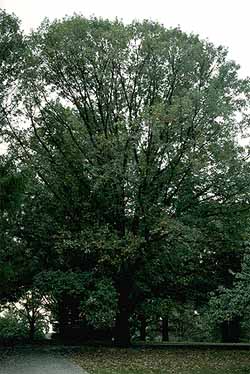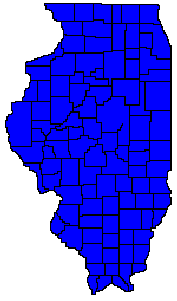 |
| Bur
Oak (Quercus macrocarpa)
Distribution
Map to Right Copyright: John Frett |

Bur Oak, also referred to as mossy-cup oak, is a large tree, reaching heights of up to 120 feet. Its trunk is straight, sometimes flaring outward at the base, and reaches a diameter of 5 feet or more. The crown of the tree consists of thick, spreading branches. Bur oak occurs throughout Illinois from dry ridge tops to lowland forests.
Interesting
Facts
Bur oak
thrives under a broad range of environmental conditions. It survives in
dry, mineral-poor soils as well as wet soils. Its thick bark protects it
from fire, and its deep taproot allows it to survive drought. It is the
most fire-resistant of the oaks and is consequently common in savannas
and prairie groves. Bur oak is also one of the most cold-tolerant oaks.
The tree is slow growing, but long lived, and may reach ages approaching 1000 years. Bur oak reproduces by seed and stump sprouting. It is commonly browsed by herbivores and grows in areas where fire is more frequent (savannas, prairies). Young bur oak shoots may be browsed or burned back only to re-sprout numerous times. This results in a root system that is older than the aerial portion of the plant.
Identifying Features
BarkUses
Bur oak bark is dark brown and deeply furrowed.
Leaves
The leaves are alternate and simple. The leaves are markedly broader at the tip than the base and are 4 to 14 inches long and up to 7 inches wide. They have 5 to 9 coarsely rounded lobes, with the sinuses (incised areas between the lobes) below the middle of the leaf being deeply incised almost to the midrib of the leaf. The leaves are dark green on the upper surface, and typically smooth. The underside of the leaf is paler green and slightly hairy.
Flowers
Male and female flowers occur separately, but on the same tree at leaf out. The males are clusters of drooping catkins.
Fruits
The acorns are also distinctive. They are usually borne singly, are oval, dark brown and can be up 2 inches long. The large cup covers 3/4 of the acorn and is hairy, with a profuse fringe of longer hairs on the lowermost scales.
Bur oak wood is durable and of high quality. It is used for cabinetry, barrels, hardwood flooring and fence posts. Native Americans used bur oak to treat heart ailments, diarrhea, broken bones, and as an astringent (to close bleeding wounds).